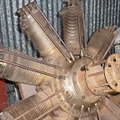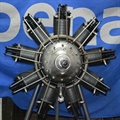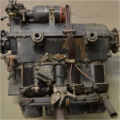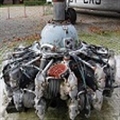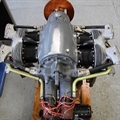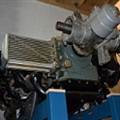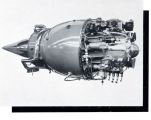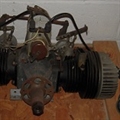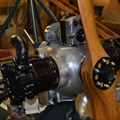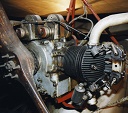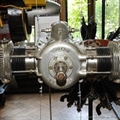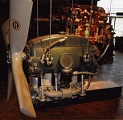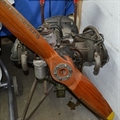Collection - Engines
early engines
Both WWI era engines in our collections are rotary engines.
Gnome 7 Lambda
Manufacturer: Société des moteurs Gnome
Status: Exhibited at the workshop
Manufacturer: Société des moteurs Gnome
Status: Exhibited at the workshop
On 6 June 1905 Louis Seguin and his brother Laurent formed the « Société Des Moteurs Gnome » to produce automobile engines. They soon started development of one of the first purpose-designed aircraft engines, combining several Gnome cylinders into a rotary engine.
Main aircraft powered by the Lambda engine: Blériot XI military, Farman HF-20, Nieuport 10, Bristol Scout, Sopwith Tabloid, Morane-Saulnier L.
Main aircraft powered by the Lambda engine: Blériot XI military, Farman HF-20, Nieuport 10, Bristol Scout, Sopwith Tabloid, Morane-Saulnier L.
Clerget 9B
Manufacturer: Clerget-Blin (Paris)
Status: Private collection
Manufacturer: Clerget-Blin (Paris)
Status: Private collection
The concept of the rotary engine (the whole engine running around a fix crankshaft) is a french innovation. The last Fokker Dr. I of Manfred von Richtofen had a french engine! And Clerget engines where (and still are) the most sought after french engine of WWI
from 1920 till 1945
We have engines of various makers, amongst which Renard, that gives a good overview of the evolution of engine technology during this period.
Renard 120 HP
Manufacturer: Avions et moteurs Renard
Status: Exhibited at the workshop
Manufacturer: Avions et moteurs Renard
Status: Exhibited at the workshop
The "Société anonyme des avions et moteurs Renard", with a capital of 2 million francs of the time, was formed in April 1925 in order to produce aircraft engines
A few engines miraculously survived the Second World War and belong to the manufacturer's family. One engine was donated to the BAPA association in 2022 by Mr Alfred-François Renard.
A few engines miraculously survived the Second World War and belong to the manufacturer's family. One engine was donated to the BAPA association in 2022 by Mr Alfred-François Renard.
Jacobs L4-MB ( R-755)
Manufacture: Jacobs Aircraft Engine Company
Status: Private collection
Exhibited at the workshop
Manufacture: Jacobs Aircraft Engine Company
Status: Private collection
Exhibited at the workshop
The model L4 appeared in 1934 and was used on numerous aircrafts. During WWII, its military version R-755 powered mainly trainers and light transport aircrafts like the Stearman and the Bobcat.
Walter NZ 120
Manufacturer: Walter
Status: Private collection
Exhibited at the workshop
Manufacturer: Walter
Status: Private collection
Exhibited at the workshop
The first model manufactured was the NZ-120 and 230 were produced from 1928 till 1934. This engine of low power was mainly used on military trainers and private aircrafts.
Salmson 9 ADb
Manufacturer: Société des Moteurs Salmson
Status: Private collection
Manufacturer: Société des Moteurs Salmson
Status: Private collection
After their production of water-cooled radial engines during WW1, Salmson decided to adopt air-cooling to reduce weight and increase specific power.
Between the two world wars, they produced a vast variety of radial engines of 5, 7 or 9 cylinders that met great success and were fitted on many aicrafts.
Between the two world wars, they produced a vast variety of radial engines of 5, 7 or 9 cylinders that met great success and were fitted on many aicrafts.
Walter Mikron II
Manufacturer: Aerotechnik &
Parma Technik
Status: Exhibited at the workshop
Manufacturer: Aerotechnik &
Parma Technik
Status: Exhibited at the workshop
The Walter Mikron is a four-cylinder, air-cooled, inverted straight engine for aircraft. Developed in Czechoslovakia in the early 1930s, the engine saw limited use in late 1930's and early 1950's. In the 1980's an initial batch of engines was rebuilt by Aerotechnik.
Pratt & Whitney R-1830-92 Twin Wasp
Manufacturer: Pratt & Whitney
Status: Uncomplete
Restorationat the workshop
Manufacturer: Pratt & Whitney
Status: Uncomplete
Restorationat the workshop
The Pratt & Whitney R-1830 Twin Wasp was an american aircraft engine widely used in the 1930’s and 1940’s years. Of classic design as a 14 cylinders in two-row air-cooled radial, its first model developed 800hp while the latest versions developed 1200hp.
After 1945
a new form of propulsion appeared as can be seen with the marboré jet engine
Lycoming O-360
Manufacturer: Lycoming Engines
Status: Exhibited at the workshop
Manufacturer: Lycoming Engines
Status: Exhibited at the workshop
This engine has been fitted on thousands of aircrafts and comprise 167 different models with 12 different prefixes. They all have the same displacement, bore and stroke.
Praga D
Manufacturer: ČKD factories
Status: Private collection
Manufacturer: ČKD factories
Status: Private collection
Praga was an important czechoslovakian firm that produced aircraft engines, aircraft and cars of their own designs that met great succes.
The Praga D engine was first produced in 1936 but enjoyed its greatest success after WWII.
The Praga D engine was first produced in 1936 but enjoyed its greatest success after WWII.
Continental O-470
Manufacturer: Continental Motors Inc
Status: Exhibited at the workshop
Manufacturer: Continental Motors Inc
Status: Exhibited at the workshop
This six-cylinder, horizontally opposed air-cooled engine is a family of aircraft engines that covers many variants from 210cv to 260cv.
The engines were first developed in the late 40’s and certified on 19 january 1951.
The engines were first developed in the late 40’s and certified on 19 january 1951.
Turboméca Marboré II
Manufacturer: Turboméca
Status: Exhibited at the workshop
Manufacturer: Turboméca
Status: Exhibited at the workshop
The Marboré was a small turbojet engine produced by the French company Turboméca. The Marboré model IIwill power the CM-170R Fouga Magister.
Our association received two Marboré from the Condorcet School (ex Université du Travail). One of the Marboré is complete, the second is a cutaway that was used to explain the operation of a jet engine.
Our association received two Marboré from the Condorcet School (ex Université du Travail). One of the Marboré is complete, the second is a cutaway that was used to explain the operation of a jet engine.
Engines for Ultra light
Ultra light airplanes have been prowered by adaptated car or motorbike engines as well as by specefically designed engines. The BAPA collection allows to discover a wide range of those very specific engines.
Aubier & Dunne "Channel"
Manufacture: Aubier & Dunne
Status: Private collection
Exhibited at the workshop
Manufacture: Aubier & Dunne
Status: Private collection
Exhibited at the workshop
Georges Aubier and his son-in-law John Dunne founded the company that bore their names in 1921 at Saint-Amand-les-Eaux in the north of France. Their company mainly produced small two stroke engines for motorcycles.
When Henri Mignet met them at a Paris car show, he convinced them to develop an engine for his HM-14 Flying Flea.
When Henri Mignet met them at a Paris car show, he convinced them to develop an engine for his HM-14 Flying Flea.
Dr Kroeber & Sohn Köller M3
Manufacturer: Dr Kroeber & Sohn Köller
Status: Private collection
Manufacturer: Dr Kroeber & Sohn Köller
Status: Private collection
This firm specialized in temperature measurement also built a small two stroke aero-engine. Due to its low power, it was mainly used on powered glider and single seater aeroplane. In Germany, its homecountry, it was used on the Grunau Baby and the Möller Stomo 3
ABC Scorpion II
Manufacturer: ABC Motor Ltd
Status: Private collection
Exhibited at the workshop
Manufacturer: ABC Motor Ltd
Status: Private collection
Exhibited at the workshop
ABC Motors Ltd was founded in 1912 to produce aircrafts engines. After WWI, it diversified into the motor industry and produced engines for cars as well as manufacturing motorcycles and light motor-cars. In 1923, a flat twin engine was manufactured for the English Electric Wren that competed in the Lympne Light Aeroplane Trials.
Sarolea Epervier
Manufacturer: Sarolea (Herstal)
Status: Uncomplete
Private collection
Manufacturer: Sarolea (Herstal)
Status: Uncomplete
Private collection
Tested on the factory roof during october 1934, it was soon fitted on the first belgian HM-14 Pou du Ciel built especially for Saroléa by Mr Pregaldien. The first test flight happened unexpectedly on 22 august 1935.
Sarolea Albatros
Manufacturer: Sarolea (Herstal)
Status: Private collection
Manufacturer: Sarolea (Herstal)
Status: Private collection
After the first successes of the Epervier and Vautour engines, Nicolas Lempereur conceived mid 1936 another engine in the same range of power destined for ultra light aircrafts.
AVA 4A-00
Manufacturer: Sima-Violet
Status: Private collection
Exhibited at the workshop
Manufacturer: Sima-Violet
Status: Private collection
Exhibited at the workshop
Marcel Violet was a famous French racing car pilot before and after WW One. He designed his own cyclecars and two stroke air cooled engines to powered them. His company Sima-Violet produced both at Courbevoie between 1924 and 1929.
Zundapp Z9-092
Manufacturer: Zünder und Apparatebau
GmbH
Status: Private collection
Manufacturer: Zünder und Apparatebau
GmbH
Status: Private collection
Zundapp was a famous german motorcycle manufacturer that produced only one aircraft engine late thirties.
The Z9-092 was a low powered four cylinders inline engine that was fitted on trainers and liaison aircrafts used by the Lutwaffe during WWII.
The Z9-092 was a low powered four cylinders inline engine that was fitted on trainers and liaison aircrafts used by the Lutwaffe during WWII.
F.N. AL.2
Manufacture: Fabrique Nationale of Herstal
Status: private collection on loan
Exhibited at the workshop
Manufacture: Fabrique Nationale of Herstal
Status: private collection on loan
Exhibited at the workshop
The Fabrique Nationale of Herstal had a famous department of motorcycles before and after WWII which also developed their owns engines.
An aircraft engines department was created early fifties to built the engines that powered the new jets of the Belgian Air Force and this was the start of a new venture in the FN history.
An aircraft engines department was created early fifties to built the engines that powered the new jets of the Belgian Air Force and this was the start of a new venture in the FN history.
Hepu KFM 40/3500
Manufacturer: Pollmann
Status: Exhibited at the workshop
Manufacturer: Pollmann
Status: Exhibited at the workshop
In Belgium, the Hepu engine was chosen to power the first version of the Tipsy Nipper in the early sixties. As it was not an homologated engine and that it only had a single ignition, it was not allowed for export and was replaced by the Stamo.

